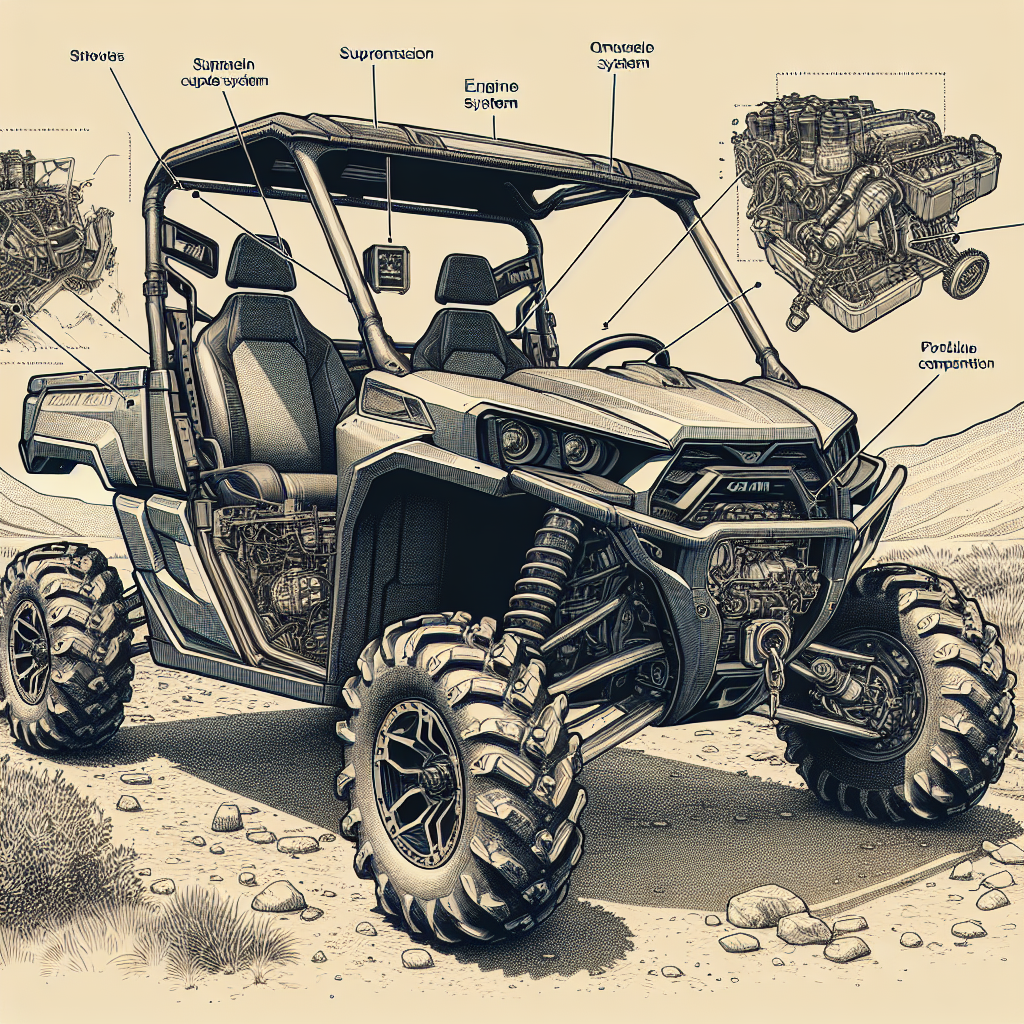The Kawasaki MULE SX is a versatile and popular utility vehicle (UTV) designed to handle a wide range of tasks from farm chores to recreational trail riding. Known for its durability and practicality, the MULE SX from Kawasaki is a go-to among off-road enthusiasts and workers who need a reliable machine. Despite its strengths, like all mechanical devices, the MULE SX is not without its issues. Owners and operators may experience certain common problems that can affect performance and reliability.
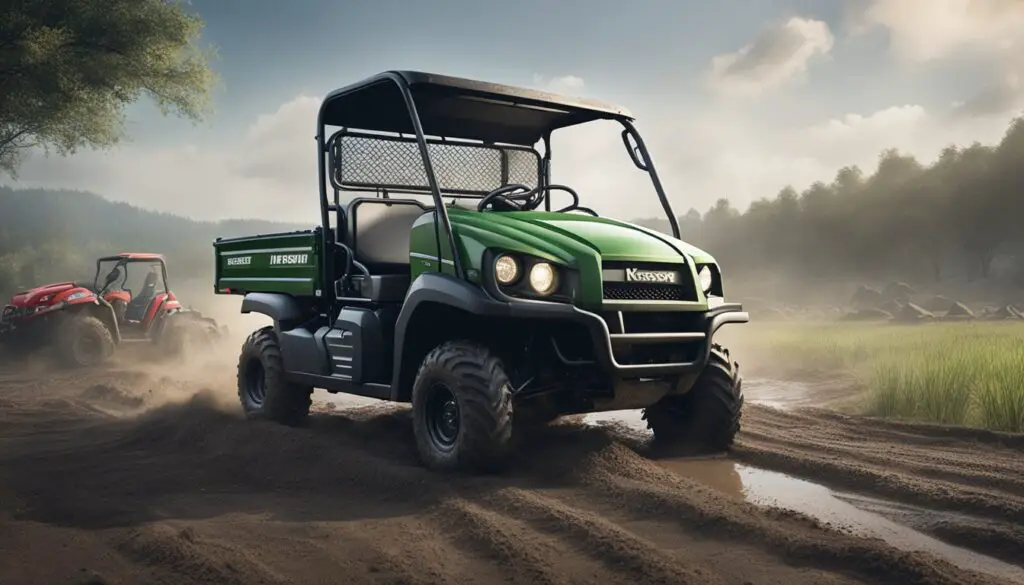
Understanding the nature of these problems is essential for timely maintenance and repair. From ignition issues to electrical complications, these challenges can interrupt the vehicle’s operation. Some users report difficulties with gear shifting, while others may notice oil leaks or find the oil filter cap popping off. Performance and handling can also be affected, with some experiencing a rough ride or squealing brakes. For owners looking to maintain their MULE SX in top condition, recognizing these signs and knowing how to troubleshoot could make all the difference in preserving the UTV’s lifespan and effectiveness.
Key Takeaways
- Familiarize yourself with common MULE SX issues for better upkeep.
- Learn simple troubleshooting tips to maintain your UTV’s performance.
- Regular maintenance is crucial for prolonging the life of your Kawasaki MULE SX.
Common Mechanical Issues
Your Kawasaki Mule SX is generally reliable, but like any vehicle, it can experience mechanical issues. Knowing the specifics can help you troubleshoot and address these problems swiftly.
Engine Problems
Your Mule SX may occasionally face engine issues such as oil leaks or overheating. If you notice oil spots where your vehicle was parked or if the engine temperature gauge reads unusually high, these could be signs of engine distress. Regular maintenance, like checking the oil filter and ensuring that the radiator is clean and functioning properly, can prevent these issues.
Electrical Issues
You might encounter electrical problems, including dim lights or an unresponsive start. These could stem from a drained battery or loose battery cables. Check your battery connections to confirm they are secure, and the battery itself should be tested and replaced if necessary.
Fuel System Complications
A faulty fuel pump can lead to your Mule SX sputtering and stalling. If your vehicle struggles to maintain power or starts with difficulty, this could indicate a problem with the fuel system. Inspecting the fuel pump and replacing it if necessary can remedy this problem.
Ignition Troubles
If your Mule SX is having trouble starting, the ignition system might be at fault. Common ignition issues include faulty spark plugs or a malfunctioning ignition coil. Ensuring your spark plugs are in good shape and replacing any faulty components can help solve ignition troubles.
Gear Shifting Challenges
Difficulty in shifting gears is another problem you might face. This can be due to a misaligned gear shift linkage or internal transmission issues. Gear shifting problems typically require professional diagnosis and repair to ensure your vehicle operates smoothly.
Remember, regular maintenance and an understanding of your Mule SX’s potential mechanical issues can enhance your riding experience and prolong your vehicle’s life.
Performance and Handling

Your Kawasaki Mule SX is engineered for reliability, but you may experience issues affecting its performance and handling, specifically concerning power loss and the suspension system.
Power Loss
When you notice a decline in the speed and vigor of your Mule SX, it’s typically a sign of power loss. This can be due to a clogged air filter, which restricts airflow and hampers engine efficiency. To resolve this, inspect your air filter and clean or replace it if it’s dirty. Regular maintenance of the spark plugs and checking for any oil leaks are also crucial to ensure adequate power generation and prevent loss of power.
Suspension Concerns
If you’re feeling every bump on the trail, your suspension system may need attention. A common complaint is a rough ride, often due to the suspension bottoming out. This could indicate worn shock absorbers or springs, which require inspection and potential replacement to improve your Mule’s handling and to prevent constant bottoming out. Regular checks can help maintain a smoother ride and improve your overall experience with the vehicle.
Regular Maintenance Challenges
Maintaining your Kawasaki Mule SX is crucial to ensure its reliability. Regular upkeep, like air filter checks and oil management, helps prevent common issues that can hinder your Mule’s performance.
Air Filter Maintenance
Your Mule’s air filter is your engine’s first line of defense against dust and debris. A dirty air filter can lead to reduced performance and even engine damage. You should routinely check and replace the air filter, especially after riding in dusty or dirty conditions. Here’s a simple way to keep it in check:
- Inspect the air filter every 50 hours of use.
- If the air filter is dirty, clean it with compressed air.
- Replace the air filter every 200 hours or annually, whichever comes first.
Oil Management Issues
Proper oil management is essential to keeping your Mule running smoothly. Oil leaks are a common problem that can cause major issues if not addressed. Ensure that oil levels are maintained, and gaskets and seals are checked to prevent leaks. Look out for these signs that may indicate oil management issues:
- Oil leaks: Regularly check for signs of leaking oil beneath the vehicle.
- Oil filler cap: Make sure the cap is securely fastened; it can sometimes become loose and lead to oil splatter.
Remember to also routinely check and replace spark plugs, as worn-out spark plugs can lead to starting difficulties and reduced engine efficiency.
Specific Component Problems
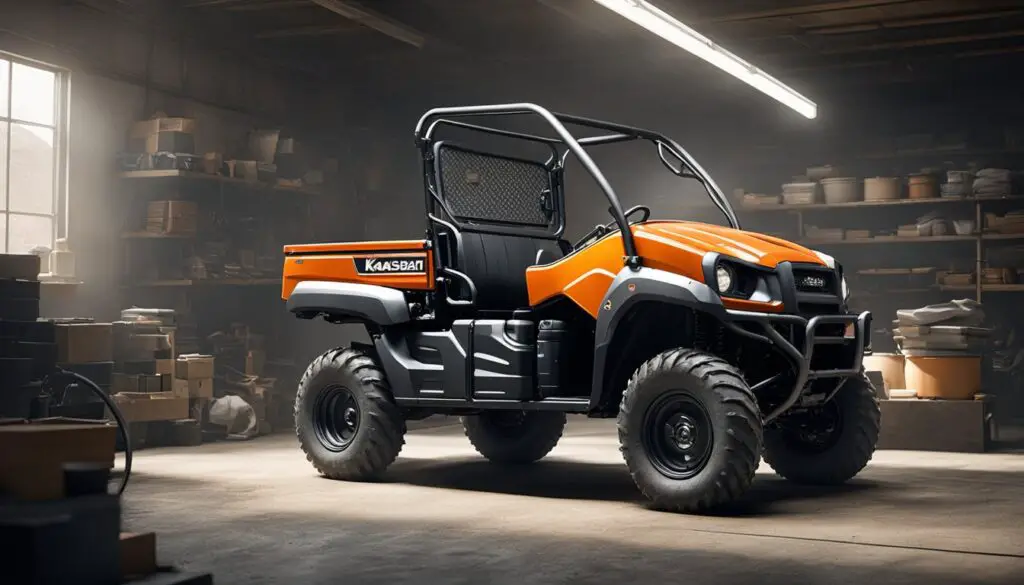
When tackling issues with your Kawasaki Mule SX, you’ll find that some problems are specific to certain components—especially the battery and parts that can cause noise.
Battery Difficulties
Your Kawasaki Mule SX’s battery is the heart of its electrical system. If you start experiencing power loss or difficulty starting the vehicle, it’s essential to check the battery first. A dead battery might simply require a jump-start to get back in action. However, if you’re facing recurring battery issues, it might point to either faulty wiring or a more systematic problem such as the charging system not working properly.
Rattling and Noise Issues
Encountering rattling sounds can be disconcerting. Generally, noise production stems from loose components or parts that have become misaligned. If you’re hearing a rattling noise while operating your Mule SX, check for any loose bolts or fittings and tighten them accordingly. A common rattling noise problem could also indicate issues with the suspension system or exhaust components that require attention.
Design and Utility Features
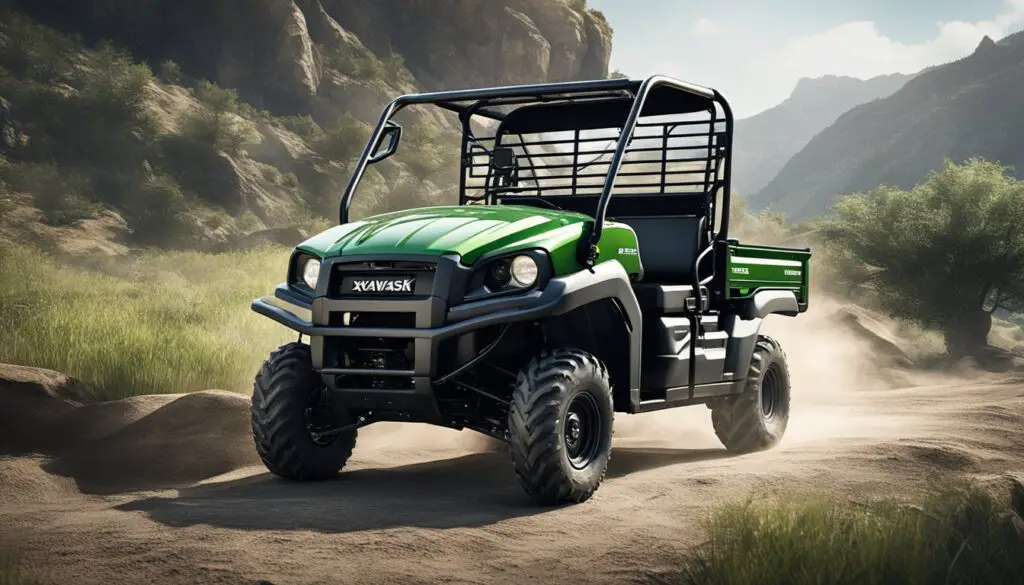
When you choose the Kawasaki Mule SX, you’re opting for a vehicle known for its utility and comfort features tailored to enhance your working experience.
Cargo and Storage
Your Kawasaki Mule SX is equipped with a tilting steel bed designed to handle demanding tasks. This bed is not just robust; its tilting capability allows you to dump loads with ease, adding practicality to your everyday work. Moreover, the added rectangular cargo guard provides an extra layer of protection for your cargo, ensuring that nothing spills out during transit, no matter how bumpy the ride gets.
Riders’ Comfort
Comfort hasn’t been overlooked in the design of your Mule SX. A tilting steering wheel provides a customizable driving position, allowing you to find the most comfortable posture for those long days on the job. The front wheels are paired with a MacPherson-strut suspension, offering a smoother ride, while the swing-axle rear suspension helps in maintaining stability over rough terrain. However, one should note the lack of side mirrors which, while not affecting comfort, does have an impact on utility by limiting your field of view.
Troubleshooting and Solutions
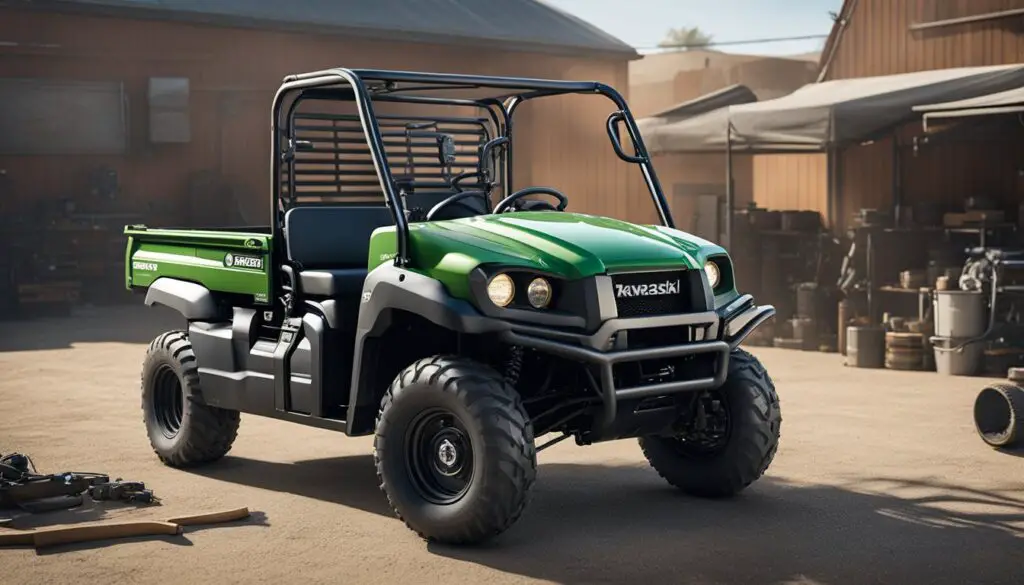
In this section, you’ll find targeted advice to diagnose common issues and effective solutions to get your Kawasaki Mule SX back in top shape.
Diagnosing Issues
When your Kawasaki Mule SX starts to sputter or stall, begins to have trouble starting, or suffers from engine misfires, it’s essential to diagnose the underlying problem accurately. A good starting point is to check the fuel delivery system as clogs or blockages can lead to these symptoms.
- Sputtering and Stalling: Examine the fuel lines and filters for signs of blockage and replace them if necessary. It may be beneficial to add a fuel additive like Seafoam to your tank to clean the engine and fuel system.
- Failing to Start: If your Mule SX fails to start, check the integrity of the ignition components, including spark plugs and wires. A malfunctioning ignition can prevent the engine from starting.
Addressing Common Faults
Once you’ve diagnosed the issue, apply the specific solution to address the fault directly. Here are some of the most common problems and how to fix them.
- Starting Problems: Ensure your battery is fully charged and the connections are clean. For persistent starting issues, inspect the starter motor and replace it if necessary.
- Engine Misfiring: Faulty spark plugs or fuel delivery issues are usually the culprits. Replace the spark plugs and ensure the carburetor is clean and functioning correctly.
- Fuel Delivery Issues: Clean or replace the fuel filter to ensure an unimpeded fuel flow. If the issue persists, inspect the fuel pump and carburetor for signs of wear or damage.
- Ignition Problems: Check the ignition coil and replace it if tests show it’s malfunctioning. Make certain that all electrical connections are secure and free of corrosion.

Frequently Asked Questions
In this section, you’ll discover some of the most pressing questions you may have about your Kawasaki Mule SX, along with straightforward answers sourced from user experiences and technical insights.
What are common issues encountered with the electrical system of the Mule SX?
Electrical challenges in the Mule SX often include sporadic power loss and ignition troubles. These might manifest as difficulty in starting your vehicle or unexpected shutdowns during operation, which are often linked to battery or alternator issues.
How does the Kawasaki Mule SX perform in terms of power and acceleration?
You might notice a reduction in your Mule SX’s power and acceleration, which can be frustrating. This is typically related to carburetor malfunctions or fuel delivery problems, which can impede your Mule’s performance.
What are frequent starter problems reported by Kawasaki Mule SX owners?
Starter issues can present as hesitance or failure to ignite the engine. This could be due to a faulty starter motor or electrical connections that might become corroded or loose over time.
Are there any recurring transmission problems in the Kawasaki Mule SX models?
Some owners report gear shifter sticking, which could lead to difficulties when changing gears. Less commonly, you might encounter rough transitions or hesitance in the gear shifting mechanism.
How reliable is the Mule SX in terms of engine performance and maintenance?
While generally reliable, the Mule SX can exhibit sputtering and stalling, often attributable to clogged air filters or issues within the fuel system. Regular maintenance and promptly addressing oil leaks can greatly enhance engine performance.
What is the average top speed of a Kawasaki Mule SX and factors that may affect it?
The Mule SX is not a high-speed vehicle by design, with top speeds typically around 25 mph. Factors such as engine condition, terrain type, and maintenance frequency can either boost or reduce this speed slightly.

